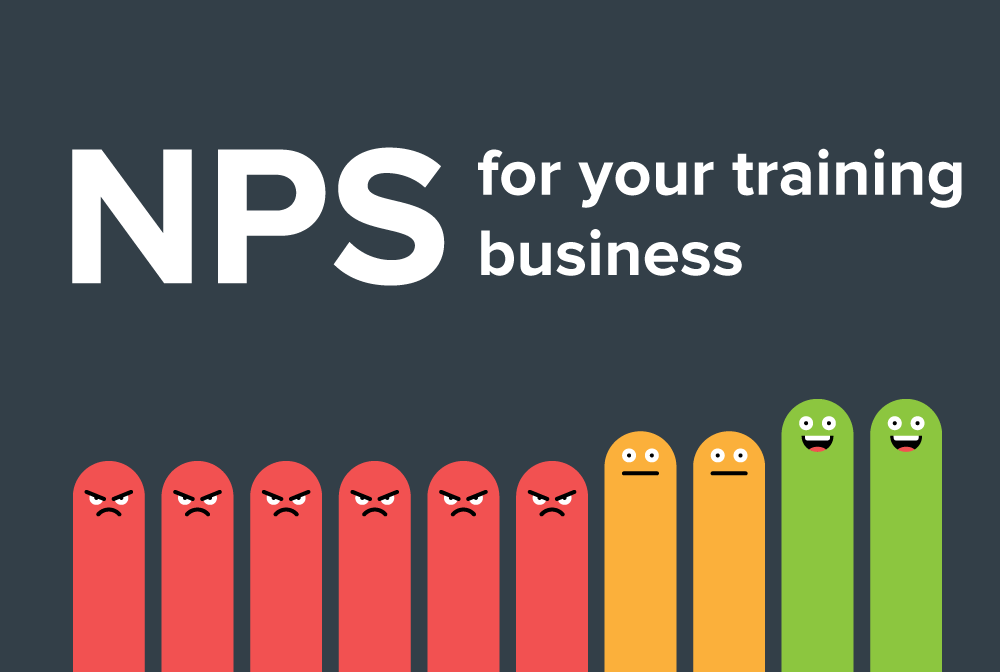Recently updated on September 11th, 2019
Your training organisation runs a programme of courses, all with different presenters, topics and groups of attendees. On the surface, everything appears fine. People come in, your presenter does their job, people leave and give positive feedback. But is everything really ok?
If your current measurement regime isn’t helping you to intimately understand your customers, benchmark your business against similar training organisations and identify areas to improve your service and products, then this article is for you.
What is Net Promoter Score (NPS)?
NPS is a survey question that could help you measure customer satisfaction and predict business growth. Let’s takes a look at how you could adopt NPS for your training or event business.
NPS is a simple survey question and calculation which can be asked on its own or in conjunction with other survey questions. The question goes:
How likely is it that you would recommend [organisation/course/event] to a friend or colleague?
Respondents give their answer on a 1 – 10 scale. Many companies will also include an open ended follow-up question for users to explain the result they gave. Respondents are then classified as a Promoter, Passive or Detractor depending on their answer.
Your business’s NPS is calculated by subtracting the percentage of promoters by the percentage of detractors.
% Promoters – % Detractors = NPS
Why NPS?
NPS is a globally recognised customer experience tool that could benefit your training organisation in a number of ways.
NPS is easy to answer, so you’ll get more responses
Due to NPS being one simple question with a scale response, it is easy for respondents to answer. If you just ask NPS on it’s own you can expect a higher completion rate compared to longer surveys. And if you add it to an existing survey, the survey will not become any more time consuming to complete.
Measures your potential growth
Your Promoters are five times more likely to purchase again from your organisation, according to Temkin Group. These Promoters are loyal to your business, and if you offer courses that are complementary or at a more advanced level, Promoters are likely to be the first to register. Loyal customers are worth 10 times as much as their first purchase, so it makes good business sense to understand why these people so satisfied.
On the contrary, having a large number of Detractors can impact your bottom line and potential growth. Not only are your Detractors less likely to register again for a course, they are also twice as likely to share their negative views than promoters are of their positive views.
Benchmarking
Because NPS is a global measurement standard, a huge amount of the data is available to compare your organization against. Industry averages are available online – just do a search in Google.
Better understanding of your registrants’ experience
Like any survey, NPS is only useful if it leads to action. The data in itself won’t change your business – what you infer from it, and what you do, will. Not only does NPS give you some immediate insight through the score and the comments that have been left, based on a customer’s response you can open up a discussion to gain some more insight as to why they feel a certain way.
- Why are Promoters happy? (You should keep on doing these things)
- What things could you change to make Passives excited?
- Why wouldn’t Detractors recommend your training business? (There may be small things you can change which have a large impact)
Limitations of NPS
One experience can skew feedback
Because the NPS question is so broad, a Detractor may have given this negative rating based on one specific item – for example, the food or venue. This leads to the second limitation…
NPS alone might not be specific enough
If you use NPS in isolation, you might not receive enough information on specific elements of your business to be actionable or understand the results. For example, you might not get specific feedback on the registration experience or course material. This is where a follow-up comment box can be useful.
Ways to use NPS in a training or event business
- Ask it after a course, about that course – if you make NPS a standard survey question across all courses you will be able to compare the results across all training and make specific changes to individual courses that need it.
- Ask it as an annual NPS survey of all customers – done in tandem with a post-course NPS, you will gain both a macro and micro view of your organization’s strengths and weaknesses.
- If you have other questions in your survey, start with NPS – it is easy to answer, which means respondents are more likely to answer the rest of your survey. For more information on this logic, check out SurveyMonkey’s article on increasing survey completion rates.
If you don’t have automated systems for managing an NPS survey, why not find out more about Arlo. Arlo has integrated its training management system with SurveyMonkey. For more information, contact Arlo Sales to schedule a demonstration today.
